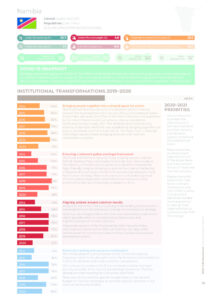Nutrition situation
Under five stunting (%)
22.7
Under five overweight (%)
4
Anaemia in women 15-49 years (%)
23.2
Under five wasting (%)
7.1
Low birth weight (%)
15.5
0 to 5-month-old exclusive breastfeeding (%)
48.3
Adolescent overweight (%)
Male: 8.9
/ Female: 19.9
Adult overweight (%)
Male: 27.2
/ Female: 51.9
Adult obesity (%)
Male: 7.5
/ Female: 25.4
Adult diabetes (%)
Male: 7.3
/ Female: 7.5
COVID-19 snapshot
Namibia responded quickly to COVID-19. The Office of the Prime Minister formed working groups to review and support the health and socioeconomic response. The multi-sector platform, which is transitioning to the Food and Nutrition Security Coordination System (currently being revised), faced challenges in ensuring nutrition sensitivity in the response.
Institutional transformations 2019-2020
Bringing people together into a shared space for action
The Food and Nutrition Security Coordination System is being revived. The Food and Nutrition Security Policy and Implementation Action Plan, driven by the Office of the Prime Minister, and supported by the United Nations and civil society, is being completed. Ratification is due in early 2021. The Nutrition and Food Security Alliance of Namibia (NAFSAN) was established, bringing together civil society, academia and the private sector. The Right Start Campaign (1000 days) was launched, bringing cross-sectoral nutrition stakeholders together.Ensuring a coherent policy and legal framework
The Food and Nutrition Security Policy is being revised, and the School Feeding Policy was revised to include local fresh produce. The Ministry of Health and Social Services (MoHSS) finalised the Baby Friendly Hospital Initiative to enforce the Code of Marketing of Breastmilk Substitutes. MoHSS with partners developed a Food Fortification Strategy. There is momentum to expedite approval of these policies, legislation and enforcement measures and parliamentarians are increasingly engaged to do so.Aligning actions around common results
Analysis of common infant and young child feeding practices led to the establishment of a behaviour change communication strategy.Nutrition was integrated into the biannual vulnerability assessment which provides data on nutrition status, behaviours and implementation of nutrition services.
Final endorsement of the Food and Nutrition Security Policy and Implementation Action Plan will facilitate the alignment and inclusion of nutrition activities into the national and sectoral development plans.
Financial tracking and resource mobilisation
The UN developed a joint proposal to the Central Emergency Response Fund for the drought and to the European Commission for COVID-19, which include major nutrition components.The German Government (GIZ) has included nutrition and food security as a pillar in its country partnership framework. This has already provided funding for civil society (NAFSAN).
There are still no nutrition specific budget lines in the national budget or nutrition strategies or nutrition-specific activities in the national development plan.
2020-2021 Priorities
- Secure resources to ensure the effectiveness of the new Food and Nutrition Security Coordination System at national and subnational levels.
- Raise awareness, at national and subnational level of the importance and interconnectedness of food and nutrition security.
- Ensure the multistakeholder task force maintains momentum and that a SUN Country Coordinator is identified, funded and empowered to take up their responsibilities as outlined in the SUN 3.0 strategy.
Download

